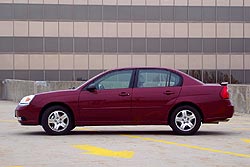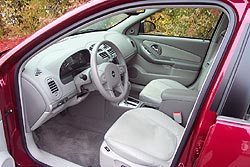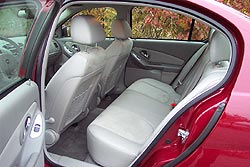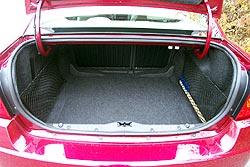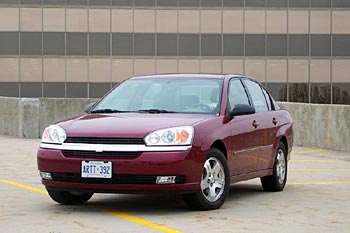 2004 Chevrolet Malibu LT model shown. Click image to enlarge |
by Greg Wilson
Photos by Grant Yoxon
Big improvements to Chevy’s new mid-size sedan
Though the 2003 Chevrolet Malibu sedan is a decent mid-sized car – it was a “Recommended Buy” by Consumer Reports two years in a row – it doesn’t quite measure up to popular imports like the Honda Accord and Toyota Camry in its overall performance, interior quality and passenger room.
Perhaps that’s why GM decided to clear the deck and start with a completely new Malibu. Based on a new global platform shared with the Saab 9-3 and available with two new engines, the 2004 Malibu offers major improvements in the areas of V6 powertrain refinement, throttle responsiveness, handling, interior room, noise levels, and passenger comfort. The new Malibu still leaves something to be desired in its interior quality, and its new Kansas City-built, European-designed Epsilon platform is yet to be tested for long-term reliability. But after more than a week test-driving the 2004 Malibu LS V6 – on road and track – I was really quite impressed with the Malibu’s overall package and value for money.
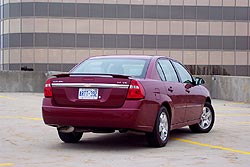
|
For starters, the 2004 Malibu’s cabin is roomier than the previous Malibu’s even though the new car is about 50 mm (2 inches) shorter. The new Malibu’s interior volume is larger by 18%, although much of that extra cabin room came from the trunk which is now 12% smaller, now 15.4 cubic feet. Still, 15 cubic feet is pretty big.
Base Malibus, which come with a 145 horsepower 2.2 litre “Ecotec” 4 cylinder engine, start at $22,160. A four cylinder engine wasn’t offered last year, but it was offered earlier on in the Malibu’s life cycle, but then dropped due to lack of demand. My guess is the same thing will happen with this four cylinder engine.
Standard features on the base 2004 Malibu are extensive, including a four-speed automatic transmission, air conditioning, AM/FM/CD stereo, power windows and door locks, power mirrors, a power driver’s seat height adjuster, manual tilt/telescoping steering column, 15 inch tires and wheels, and front disc/rear drum brakes (ABS is optional). That makes the base car a very good value.
Malibu LS and LT models, which start at $24,695 and $29,220 respectively, come with a new 200 horsepower 3.5 litre overhead valve V6 – an improvement from the 170 horsepower 3.1 litre V6 engine offered in the 2003 Malibu. LS models include cloth seats, CD player with six speakers, standard ABS and traction control, cruise control, power adjustable pedals, manual lumbar driver’s seat adjustment, remote keyless entry, wood trim, and alloy wheels. LT models add leather upholstery, 6-way power driver’s seat, heated front seats, curtain airbags, fog lamps, 16 inch tires and alloy wheels, rear spoiler, four wheel disc brakes, remote starter, upgraded interior trim, premium stereo, and Onstar.
Interior impressions
The interior of the Malibu LS is roomy and bright with large windows and good driver visibility. With its fairly flat hood and trunklid (a rarity these days) the driver can actually see the forward edges and tail of the car making it easier to park and back up. There’s lots of headroom and legroom for front and rear passengers and the big doors make it easy to get in and out. The Malibu seats five and there are five 3-point seatbelts, but only four height-adjustable head restraints.
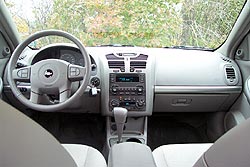
|
The driver’s seat is height adjustable, the steering wheel can be tilted or pulled in and out, and the optional power adjustable brake and accelerator pedals compensate for shorter or longer legs – still I had a hard time finding a comfortable driving position. I still can’t figure this out.
The front seats are reasonably comfortable with adequate side support, however the look and quality of the cloth seat materials is below average in this class, and I found the rear seat seatbacks a bit stiff. The quality of the dash materials is generally good with the exception of the smooth centre portion and the rather tacky control knobs. I liked the position of the ignition on the dash where it’s easier to reach than on the steering column.
Once seated, the driver faces three round gauges – tachometer, speedo and fuel/coolant gauges that are marked with simple white numerals on a black background. The gauges don’t have the precision look of the dials in the Camry, Mazda6 and Accord, but they’re functional. On Malibu LT models, buttons for the radio and cruise control are located on the steering wheel spokes.
The centre console is easy to reach and the illuminated display, which includes radio stations, digital clock, outside temperature indicator, and trip computer, is bright and easy to read.
The radio/CD player has six different pre-set sound modes: classical, country, jazz, rock, pop, and reggae – this saves having to adjust treble, bass, fader modes for different kinds of music, but it’s not something I would pay extra for. Many of the radio controls have symbols which aren’t immediately obvious.
Optional is an uplevel radio with an in-dash, six-CD changer, six speakers, and automatic volume control.
The heater is simple and easy to use, and the two vents on the centre of the dash are designed to blast generous amounts of air directly into the back seat. Underneath the heater is a small slot just big enough for a cell phone, and a handy 12 volt outlet for charging. In addition, there’s a 12 volt powerpoint and a cell-phone holder inside the large centre storage bin between the seats.
Some thought went into the interior ergonomics: note how the shift lever is placed on the left side of the centre console where it’s easier to reach, and the power window buttons are angled towards the driver.
The trunk has a large opening, a lined interior, and the two levers for releasing the split folding seatbacks are handily located just inside the trunk at the top.
Driving impressions
Behind the wheel of the V6-powered Malibu, two things immediately impressed me: the responsiveness of the throttle and the quiet, vibration-free interior. The new overhead valve 3.5 litre V6 with two valves per cylinder is based on the current 3.4 litre V6 used in GM’s minivans. With this engine, 0 to 100 km/h times are a decent 8.5 seconds (according to independent tests conducted by the Automobile Journalists Association of Canada (AJAC)), but this doesn’t really reflect the Malibu’s tremendous low-speed responsiveness where, for most drivers, most of their driving is done. From a stoplight, or pulling out in traffic, the Malibu V6 has plenty of punch, and does it without hesitation or effort. Maximum torque of 220 lb-ft is available at just 3200 rpm, compared to between 4000 and 5000 rpm for many of its competitors – and torque steer is minimal. With its larger displacement and overhead valve design, the Malibu doesn’t really need variable valve timing to create extra torque.
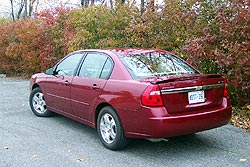 Click image to enlarge |
Once you’re up to highway speeds in the Malibu, the 3.5 litre V6 ambles along quietly and smoothly, doing only 2100 rpm at 120 km/h in fourth gear.
Even though the new V6 is bigger and has more power, fuel consumption has improved according to GM’s figures. City fuel consumption is 10.4 l/100 km (27 mpg) and Highway consumption is 6.8 l/100 km (42 mpg). The engine uses Regular fuel, but I noticed there is no locking fuel door or gas cap.
The standard 4-speed automatic transmission changes smoothly without any hesitation or jumpiness. It has an unusual feature: in “Low” you can manually switch between 1, 2 and 3 gears by pressing a “+” or “-” button on the handle of the shift lever. This gives you some manual control when motoring around town, or climbing a hill, or descending a grade. Many of the Malibu’s competitors now have 5-speed automatic transmissions, but I didn’t sense any need to have an extra gear in the transmission. This one works just fine.
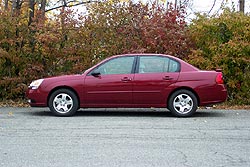 Click image to enlarge |
With a fully independent suspension (front independent MacPherson coil-over-strut and isolated front chassis cradle; rear independent 4-link design), the Malibu handles surprisingly well. It leans slightly on initial turn-in, but it holds steady and feels well-balanced despite its 63% front weight bias. Only the standard 15 inch Bridgestone B450 205/65R-15 inch tires prevent better handling.
The new electro-hydraulic, variable-assist power steering offers a lighter feel at slower speed and firms up well at higher speeds. The steering is fairly quick, but what disappointed me was the 11.6 metre (38 feet) turning circle, up from 11.0 metres (36.3 feet) in the 2003 Malibu.
The front disc/rear drum brakes (with ABS) on my test car offered good, solid pedal feel, but independent braking tests conducted by AJAC indicate a greater-than-average braking distance of 45 metres (147.5 feet) from 100 km/h to 0.
The cabin is very quiet – GM included a lot of sound deadening material including a foam-rubber barrier inside the dash panel; a fiberglass-composite hood insulator; and front and rear carpet floor modules. A sporty exhaust note on hard acceleration, and occasional suspension thumps over rough roads were the only noise intrusions.
Remote starter
The Malibu is the first production car to offer a remote starter (standard on LT, optional on LS). It can be started at a distance of up to 61 metres (200 feet), assuming there are no other cars or obstacles between you and the car, simply by holding down on a button on the key fob for one and a half seconds. The same button shuts off the engine if it is pressed again.
For safety, the Malibu must be locked before the remote starter will work. I found that even if you locked the car an hour ago, you must re-lock it before the remote starter will work. After starting, the engine will shut off after ten minutes if the car is left running. As well, the factory-installed remote starter is integrated with the engine computer to make sure that all systems are functioning normally before the car will start.
The major benefit of the remote starter is the ability to start the car in sub-freezing temperatures, or really hot temperatures, before getting in. In Winter, the heater and air conditioner can be left in the defrost position to help de-ice the windscreen and heat up the interior before getting in. However, I noticed that the rear defroster won’t come on when the car is started until the driver presses the defrost button. My test car didn’t have seat heaters, but I suspect these will not turn on automatically when the car is started remotely either. In the sweltering heat of summer, the remote starter can cool down the interior before the driver and passengers get in.
Critics say leaving the engine running while the car warms up creates unnecessary pollution. That may not be true in Winter. If a car is left outside in Winter, most drivers start the car and leave it running while they scrape the windows and heat up the interior. If the interior is already heated up, it will take considerably less time to clear the windows.
Early in 2004, Malibus will be available with OnStar’s Automatic Crash Notification System. Sensors in the car detect if the vehicle has been in a collision and automatically notify OnStar representatives. Currently, Onstar is notified only if the airbags deploy.
Competitors
Competitors for the Malibu LS V6 ($24,695) include the Toyota Camry LE V6 ($27,070), Honda Accord LX V6 ($29,100), Mazda6 GS V6 ($28,195), Chrysler Sebring Touring ($25,695), and Ford Taurus SE ($26,715).
Verdict
A well-priced mid-sized sedan with great performance and a roomy, comfortable cabin, the 2004 Chevrolet Malibu V6 is a good value in the mid-size sedan class. Its conservative styling, average interior quality and lack of a 5 year powertrain warranty are it weakest points.
The 2004 Malibu sedan is manufactured in Kansas City, Kansas.
Technical Data: 2004 Chevrolet Malibu LS
| Base price | $24,695 |
| Freight | $900 |
| A/C tax | $100 |
| Options | $1,210 (“1SB Package” includes remote starter, side curtain airbags, power 6-way driver’s seat, rear spoiler |
| Price as tested | $26,905 |
| Type | 4-door, 5-passenger mid-size sedan |
| Layout | transverse front engine/front-wheel-drive |
| Engine | 3.5 litre V6, OHV, 2 valves per cylinder |
| Horsepower | 200 @ 5400 rpm |
| Torque | 220 lb-ft @ 3,200 rpm |
| Transmission | 4-speed automatic |
| Tires | Bridgestone P205/65R-15 |
| Curb weight | 1495 kg (3297 lb.) |
| Towing capacity | 454 kg (1000 lb.) |
| Wheelbase | 2700 mm (106.3 in.) |
| Length | 4783 mm (188.3 in.) |
| Width | 1775 mm (69.9 in.) |
| Height | 1460 mm (57.5 in.) |
| Cargo volume | 436 litres (15.4 cu. ft.) |
| Fuel consumption | City: 10.4 l/100 km (27 mpg) |
| Hwy 6.8 l/100 km (42 mpg) | |
| Warranty | 3 yrs/60,000 km |






